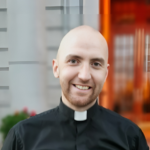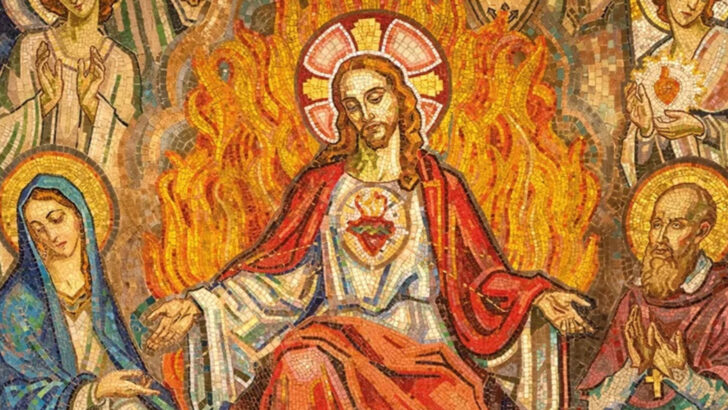Allow our hearts to be transformed on St Valentine’s day, says Fr Barry White
As St Valentine’s Day approaches, February 14 brings to mind red roses, love hearts, chocolates, candlelit dinner for two and couples escaping on weekend city trips. Meanwhile, those of us who are celibate quietly mark the feast of Sts Cyril and Methodius. Love, in all its facets, takes centre stage – songs, poems, sitcoms, and reality shows attempt to capture its dizzying highs and devastating lows. From unrequited love to heartbreak, from Shakespeare’s Romeo and Juliet to Ross and Rachel in Friends, the emotional depths of the heart have long been a symbol of intimacy, affection, and profound connection. More than just a bodily organ or metaphor, the heart is a “symbol of personal intimacy, affection, emotional attachment, and capacity for love” (Pope Francis, Dilexit Nos, 53).
At the heart of our Faith is the Sacred Heart of Jesus, who reveals God to us (excuse the pun!). Joseph Ratzinger writes that in Jesus, God “has a face and seeks our face; he has a heart and seeks our heart.” In Christ, we encounter God’s heart made visible, expressing divine love in human ways. John’s Gospel depicts Jesus dwelling in the Father’s heart (John 1:18) and making it known to us. At the Last Supper, the beloved disciple rests on Jesus’ chest (John 13:23-25), symbolising intimacy with God. Sighing in prayer for healing (Mark 7:34), and weeping at Lazarus’ tomb (John 11:33).
Rediscover
Pope Francis’ encyclical Dilexit Nos urges us to rediscover the Sacred Heart and the human heart. He warns that our technocratic age risks eroding authentic connection and reminds us that, despite its complexities, the heart defines our humanity and capacity for love and truth. While Scripture cautions that the heart can deceive (cf Jeremiah 17:9), it is also the seat of sincerity, revealing true intentions. The Catechism teaches that the heart is the “dwelling-place where I am, where I live”; it is the place of decision, encounter, and covenant (CCC 2563).
In an age dominated by efficiency and autopilot routines, the dialogue between heart and mind is increasingly muted”
Throughout history, writers and thinkers have wrestled with the heart’s significance. Whether in literature – Johann Wolfgang von Goethe’s Faust lamenting, “Two souls dwell, alas, in my breast”—or music – Bruce Springsteen’s The River with its lyrics, “Everybody’s got a hungry heart”— the heart transcends science, expressing humanity’s deepest experiences of love, grief, despair, hope, and courage. Beyond romance, the heart reveals itself in the passion and determination of sport, as we’re witnessing in the 6 Nations, the courage of choosing a career, or the searching experience of discerning a vocation. Yet, in an age dominated by efficiency and autopilot routines, the dialogue between heart and mind is increasingly muted.
Evolved
The idea of the heart has evolved over time, from ancient Greece to modern thinkers. In Homer’s Iliad, the heart is where reason and emotion meet (Iliad X, 244; XXI, 441). Plato, in the Phaedrus (246a), compares the soul to a charioteer controlling two horses – one noble, one unruly -symbolising our higher aspirations and lower base passions. The heart is where reason tries to balance these forces, guiding us toward virtue.
In the medieval scholastic tradition, particularly in Thomism, the heart is linked to the sensory appetite and passions. Thomas Aquinas (ST I-II, q. 22, a. 3) incorporates Aristotelian anthropology, emphasising intellect, will, and sensory appetite. While not a distinct faculty, the heart is central as the seat of passions – responses of the sensory appetite to perceived good or evil.
Modernity’s emphasis on reason and science often marginalised the heart’s role in philosophical anthropology. The scholastic tradition and early modern philosophy largely neglected the heart, perhaps because emotions were seen as unpredictable, subjective, and erratic—akin to Plato’s unruly horse representing base passions. Thus, François de La Rochefoucauld (1613–1680) observed, “The heart is forever making the head its fool”. However, Blaise Pascal (1623–1662), in Pensées, defended the logique du cœur, emphasising the heart’s intuitive grasp of deeper truths inaccessible to reason alone.
John Henry Newman, a 19th century theologian and philosopher, further rehabilitated the heart within a personalist framework. For Newman, the heart is the seat of the affections, essential for true happiness and spiritual life. He contended that movements of the heart, such as love, hope, and reverence, are fundamental to human flourishing – “heart speaks to heart” (cor ad cor loquitur).
For von Hildebrand, the heart is the core of the affective sphere, indispensable for genuine responses to moral value and the integration of emotional and spiritual life”
Dietrich von Hildebrand (1889–1977), building on the personalist tradition, offers a defence of the heart as a central dimension of human existence. He challenges the traditional philosophical emphasis on intellect and will, arguing that the heart is equal in dignity and, together with these faculties, forms a triad essential to the human person. For von Hildebrand, the heart is the core of the affective sphere, indispensable for genuine responses to moral value and the integration of emotional and spiritual life (cf The Heart). He critiques Thomism for its limited recognition of spiritual affective action, advocating instead for a more balanced view that fully honours the heart’s role in moral and spiritual growth.
Drawing on the parable of the Good Samaritan (Luke 10:25-37), von Hildebrand illustrates how authentic moral action integrates heart, intellect, and will. The Good Samaritan’s compassion compels his selfless response, transcending mere duty. As John B. Keane writes, the heart is “that great institute of compassion and repository of human hope”. Von Hildebrand critiques Kantian ethics, which grounds morality in duty rather than love. Guided by mercy, the Good Samaritan recognises the value of the injured man and translates this recognition into action. Pope Francis, in Fratelli Tutti (88), describes this as a “law of ekstasis”, where love expands one’s existence. Von Hildebrand affirms that love unites heart, will, and intellect, enriching moral action.
Profound
In a world shaped by efficiency and technology, the heart remains the profound seat of human experience – where love and truth converge. We are invited to treasure life’s mysteries in our hearts, harmonising intellect and emotion into a deeper understanding of truth. Whether in theology, literature, or philosophy, the heart reveals our shared longing for connection and meaning. Allow your hearts to be transformed by the fullness of love and truth this St Valentine’s day.
Fr Barry White, based in Mullingar Parish, studied Philosophy, History and Theology at the Pontifical University, St Patrick’s College, Maynooth and holds a Licentiate in Canon Law.


 Fr Barry White
Fr Barry White Sacred Heart of Jesus
Sacred Heart of Jesus 
